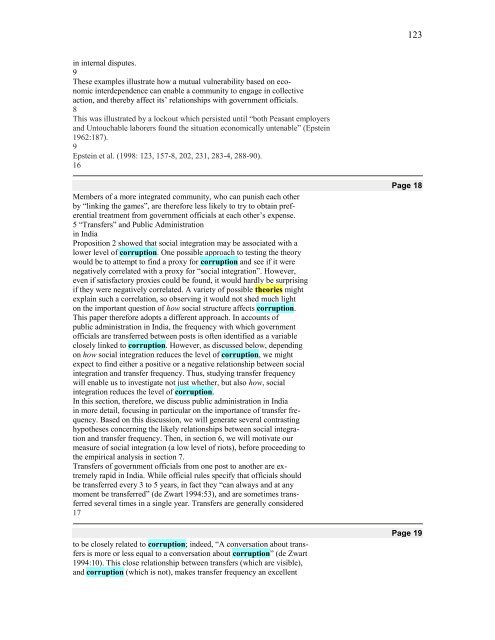FILSAFAT KORUPSI - Direktori File UPI
FILSAFAT KORUPSI - Direktori File UPI
FILSAFAT KORUPSI - Direktori File UPI
You also want an ePaper? Increase the reach of your titles
YUMPU automatically turns print PDFs into web optimized ePapers that Google loves.
in internal disputes.<br />
9<br />
These examples illustrate how a mutual vulnerability based on eco-<br />
nomic interdependence can enable a community to engage in collective<br />
action, and thereby affect its‟ relationships with government officials.<br />
8<br />
This was illustrated by a lockout which persisted until “both Peasant employers<br />
and Untouchable laborers found the situation economically untenable” (Epstein<br />
1962:187).<br />
9<br />
Epstein et al. (1998: 123, 157-8, 202, 231, 283-4, 288-90).<br />
16<br />
Members of a more integrated community, who can punish each other<br />
by “linking the games”, are therefore less likely to try to obtain pref-<br />
erential treatment from government officials at each other‟s expense.<br />
5 “Transfers” and Public Administration<br />
in India<br />
Proposition 2 showed that social integration may be associated with a<br />
lower level of corruption. One possible approach to testing the theory<br />
would be to attempt to find a proxy for corruption and see if it were<br />
negatively correlated with a proxy for “social integration”. However,<br />
even if satisfactory proxies could be found, it would hardly be surprising<br />
if they were negatively correlated. A variety of possible theories might<br />
explain such a correlation, so observing it would not shed much light<br />
on the important question of how social structure affects corruption.<br />
This paper therefore adopts a different approach. In accounts of<br />
public administration in India, the frequency with which government<br />
officials are transferred between posts is often identified as a variable<br />
closely linked to corruption. However, as discussed below, depending<br />
on how social integration reduces the level of corruption, we might<br />
expect to find either a positive or a negative relationship between social<br />
integration and transfer frequency. Thus, studying transfer frequency<br />
will enable us to investigate not just whether, but also how, social<br />
integration reduces the level of corruption.<br />
In this section, therefore, we discuss public administration in India<br />
in more detail, focusing in particular on the importance of transfer fre-<br />
quency. Based on this discussion, we will generate several contrasting<br />
hypotheses concerning the likely relationships between social integra-<br />
tion and transfer frequency. Then, in section 6, we will motivate our<br />
measure of social integration (a low level of riots), before proceeding to<br />
the empirical analysis in section 7.<br />
Transfers of government officials from one post to another are ex-<br />
tremely rapid in India. While official rules specify that officials should<br />
be transferred every 3 to 5 years, in fact they “can always and at any<br />
moment be transferred” (de Zwart 1994:53), and are sometimes trans-<br />
ferred several times in a single year. Transfers are generally considered<br />
17<br />
to be closely related to corruption; indeed, “A conversation about trans-<br />
fers is more or less equal to a conversation about corruption” (de Zwart<br />
1994:10). This close relationship between transfers (which are visible),<br />
and corruption (which is not), makes transfer frequency an excellent<br />
123<br />
Page 18<br />
Page 19

















